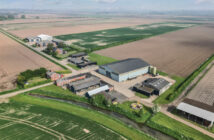* Class leading yield rivals hybrid 6-row winter barley options
* Highest combined score for Rhynchosporium, Net Blotch and lodging resistances on new RL
* Ideal variety for expanding arable rotations and spreading workloads
KWS Tardis is the highest yielding 2-row winter barley on the new 2021/22 AHDB Recommended List, with a performance that rivals many 6-row hybrid varieties, says KWS’ Kirsty Richards.
Following the company’s Sowing for Peak Performance (SPP) principles to help growers meet future production challenges head-on, KWS Tardis combines UK-wide yield potential with consistent performance in a wide variety of growing conditions, she says.
“KWS Tardis achieves a yield of 106% of controls on the new 2021/22 RL – just 1% point behind the highest yielding 6-row hybrid.
“The variety is particularly strong in the East of the country and performs well on light soils although it is best on heavy ones, where yields are at 110% of controls.”
“Add in an excellent agronomic package, including a 7 for Rhynchosporium resistance, a 5 for Net Blotch resistance and an 8 for lodging resistance, giving KWS Tardis the highest score for these traits combined, and you can see why it’s the new class leader.”
Barley Yellow Mosaic Virus resistance, allied to stiff straw and superb in-field performance, make it a great choice for growers looking for a simple and reliable way to expand their rotations and spread workloads across the farm, Kirsty Richards adds.
“In a recent survey conducted by KWS, nearly 60% of UK growers agreed or strongly agreed that UK farming is losing out across the rotation by not growing enough winter barley and KWS Tardis could be the ideal variety to address this.
“The variety’s key features will be of particular benefit in allowing more timely agronomic interventions in wheat crops with its earlier harvesting potential leading to increased revenue security and a better entry for oilseed rape crops.
“It’s the complete all-round package. A strong variety from a well-recognised and successful breeding programme allied to class-leading security of harvest, high yield capability and outstanding disease resistance.”
Trade view
Openfield’s arable technical manager Duncan Durno says KWS Tardis will have broad appeal for barley growers across the country.
“Obviously its headline figure is the yield but there’s a lot more to KWS Tardis than just that. It’s got a really strong set of features that will make it appeal to all barley growers wherever they are.
“In the East, that yield figure and high specific weight are really going to make it attractive to any feed barley grower, but the variety’s Rhynchosporium score of 7 helps make it a safe bet wherever you are.
“In the West of the country, for example, a strong Rhynchosporium score is important in potentially wetter conditions, but KWS Tardis’, long, tall straw is going to be an added bonus to livestock producers and home-feeders in the region.
“The good thing about KWS Tardis is that its straw length is not at the expense of standing power as it has a strong lodging resistance score too. Its Net Blotch resistance is pretty solid as well.”
The other key feature of the variety is the potential flexibility it will add to rotations, he says.
“With the good oilseed rape crops we generally have in the ground at the moment, this is a crop that could now have a better future in the UK than many were predicting.
“What is increasingly clear, however, is that oilseed rape success depends on having flexibility around sowing date so crops are drilled in the best conditions they can be.
“A strong, reliable and early harvesting winter barley in the rotation is one of the better ways of giving growers the time and space they need to choose the best drilling date possible rather being forced into a narrow number of options.
“Even without rape, such a variety will give you many more management options in your business and the yield, disease resistance and physical features of KWS Tardis makes it the perfect choice for this. I think it’s going to be a really popular variety.”




